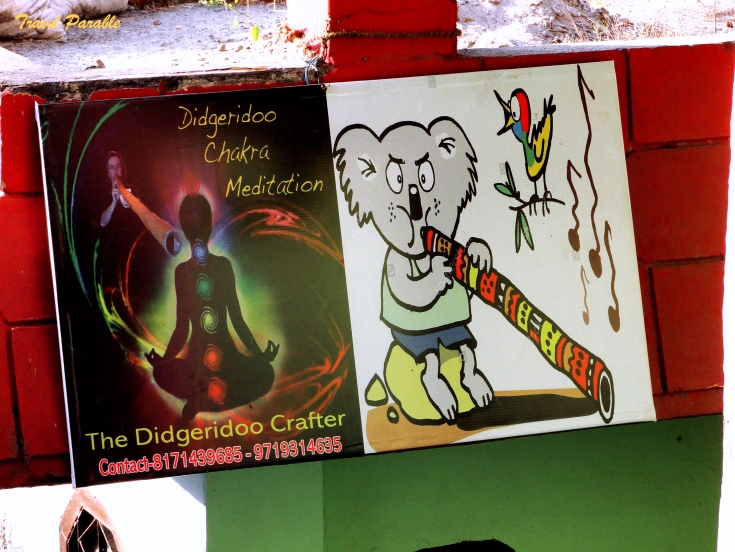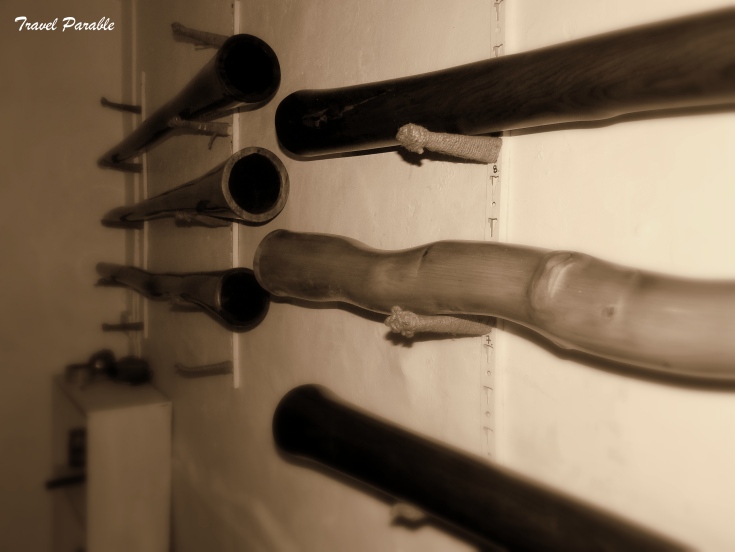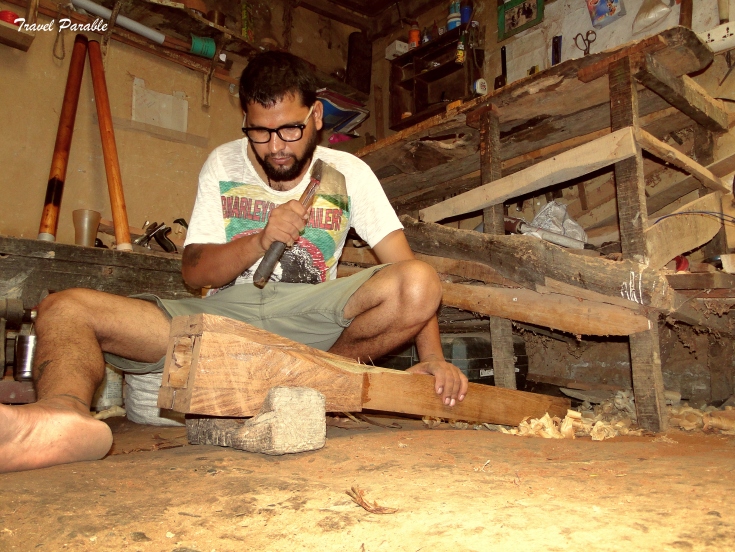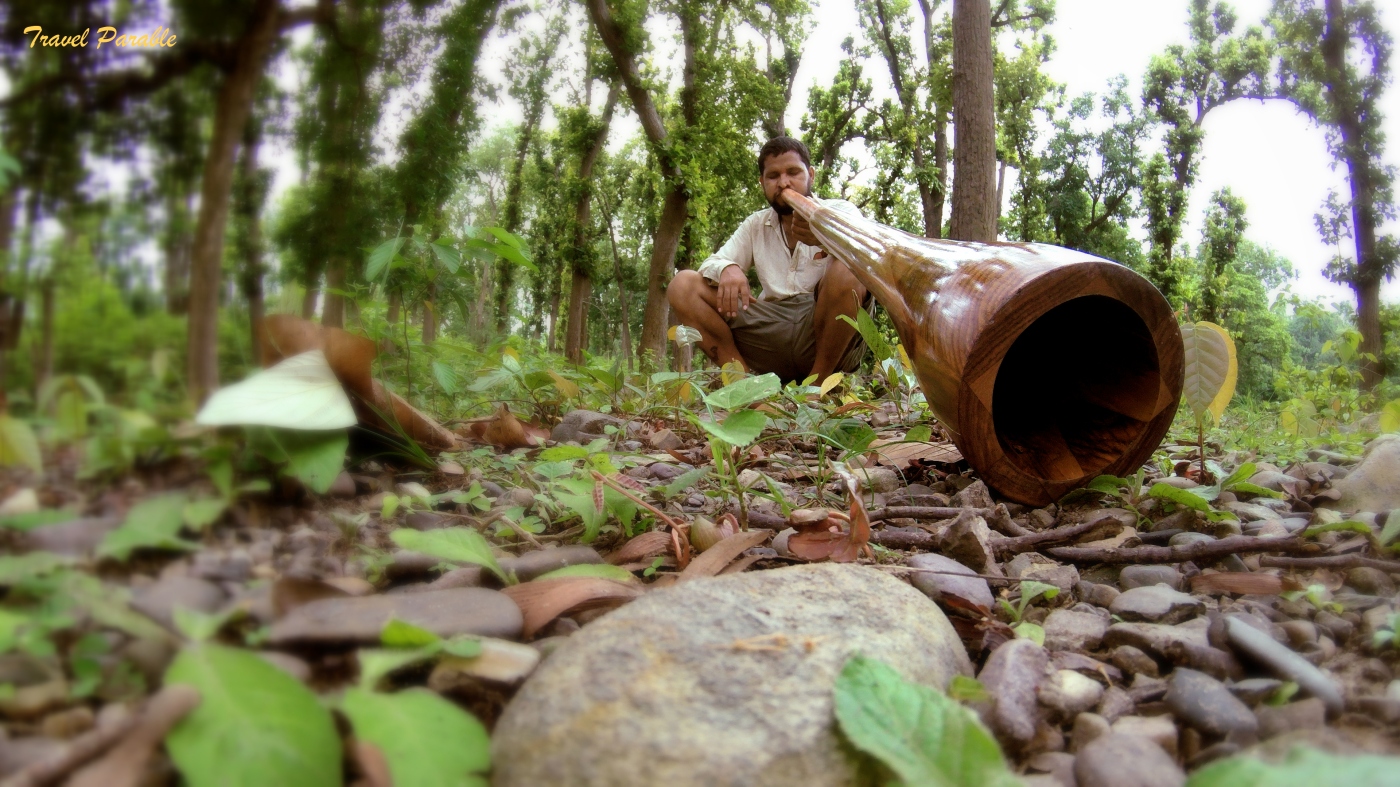While moving up on the stairs from Ganga Beach cafe to the main market street of Rishikesh, a very conspicuous sound, coming from the window of a room, attracted my attention. The sound was characterised by strong unmelodious vibrations but yet mysterious, soulful and attractive. Those vibrations also sounded a little bit familiar to me. From outside, that room appeared as if installed later in an old building. My eyes started to scan the walls of the building for any kind of information related to that enigmatic sound. I spotted a few hoardings, one of which had an image of a traditionally decorated Aboriginal man with long bell shaped colourful pipes. My running eyes were quick to catch a few familiar words like ‘class’, ‘lessons’, ‘meditation’ etc. which made me understand that it was a kind of school that links meditation with vibrations from a wind instrument. As it was around 8:30 pm, I decided to meet the meditation /music teacher of that school on the next day.

Next day I reached there by 2 pm but I was welcomed by a locked gate. In the bright daylight, my eyes passed over the hoardings again, this time in much detail, and for the first time became aware of a new term, ‘Didgeridoo‘. I made a call on one of the contact numbers mentioned on the board. On the other end, I heard the voice of a man who introduced himself as Prakash, the didgeridoo guy. He explained that for some work he had moved to the mountains and would not be available for next 2 to3 days. Assuming that I would remain unfamiliar with that instrument, as I had already decided to move to Nepal in next few days, I got involved in other interesting activities of that holy town.

On the next day, while passing through the same street at around 8 pm, I was surprised to see the room unlocked. I did not repeat the first-day mistake and immediately stepped in. The room was as small as I had assumed from outside. The height of the walls was much more than the horizontal dimensions combined. That narrow chamber had no space to accommodate more than 7 or 8 people at a time. The dim electric lamp was giving it an appearance of a semi-dark cave. For cross-ventilation, there were only a window and a door. There were no chairs but only thick mats on all the sides of the walls, except on the side of the entry door. The walls were loaded with bell shaped long wooden pipes. There were only two guys, both involved in some kind of deep conversation. When I interrupted and introduced myself as the person who made a phone call on the previous day, one of them, Prakash, immediately recognised me and invited me to come in and get seated on the mat. We started with a normal introduction but soon shifted the discussion to the instrument. The very first thing I corrected was the pronunciation for the term didgeridoo (Didge). His reaction for my query about the person who plays the didge was as if I had asked a wrong question. He appeared so normal person that at first I was not convinced he was a didge player. And when I asked about the place he had gained the instruments from, his reply that he made all the wooden instruments I could see around on his own, made me wonder that the guy next to me was not just a Didge player but also a crafter. By the end of our 10-15 minutes long conversation, I was convinced that I would take the didgeridoo lessons. Since it was late, he asked me to join from the next day. Soon after leaving the room, the mention of ‘first class free’ on one of the hoardings made me to turn back and ask about that deal. His smile informed me that my first free class was already over, but he happily agreed for not to count our first meeting as the first class.


Next day I reached at the didge shop before the owner. After a few minutes, Prakash also arrived. Before getting seated at our respective places, he cleaned the room and lighted up the joss sticks. He pointed towards one of the longest but lightest didgeridoos, made up of fiber, which according to him was the best one to start with. In the next moment, I saw him playing the didgeridoo for the first time when he demonstrated, for 15-20 seconds, how to blow the air inside the pipe. The key was to vibrate the lips while forcing the air into the mouthpiece of the instrument. Following his instructions, within next 3-4 minutes, I learnt the technique to blow the pipe. He told me to keep practicing the same lesson for the remaining time of the first day of the training. He had informed me that initially the vibrating lips would give burning sensation but advised to ignore those temporary sensations. Although I did not expect to be there for more than an hour, I was there till the time he closed the shop to go back to home. In early 3 hours, I had assumed that playing the didgeridoo requires only to blow the air inside the pipe in a particular way, stop, inhale and to repeat the same in a cyclic manner. But the real overwhelming demonstration came after 3 hours when Prakash played the instrument in a hallucinatory manner, without any break in the sound, for more than 15 minutes. I was confused to understand when he breathed in and how to play that kind of continuous sound. It was the moment when the energy of vibrations penetrated deep in my mind and soul as I could not just hear the sound but also visualise the pattern of vibrations. It was the effect of a technique called circular breathing which involves blowing out from the mouth and breathing in from the nose simultaneously. For the next 9 days, I regularly practiced the didge at his shop. Before leaving to Nepal, he crafted a light weight travelling slide didge for me. During my one and a half month stay in Nepal, I practiced it but was unable to grasp circular breathing. When I came back to Rishikesh again, Aakash, one of the students of Prakash, helped me to catch the circular breathing within 5 minutes.

In those 10 days, I did learn not only basics of didge but also had a very enlightening conversation with Prakash. Prakash is playing the instrument from past 20 years. He received the art of playing and making the instrument from his elder brother, Dharma. In his very early age, Dharma identified his love for the woodwork and started to develop his carpentry skills under the guidance of skilled woodworkers of Rishikesh. Dharma learnt to play and craft the Didgeridoo from an Australian tourist who once visited Rishikesh around 25 years before. As a result, Prakash also got familiar with the didge in his very early age. Today Prakash uses 4 kinds of wood to craft the Didgeridoo: Rosewood, Himalayan Cedar, Red Cedar and Teak. Didgeridoo was first discovered and invented by the native aboriginal people of the warm and dry land of Australia. It was discovered in the sense that perhaps in the physical form it was there from a long time. Some Australian termite species are known to eat the wood from inside, leaving the hollow timber in the field. But as a wind instrument, it was invented by those people who first blew the air inside the hollow wood and found the sound captivating. Since genetically the Aboriginal people are very close to the Indians, Prakash believes that the instrument is as much Indian as is Australian. In fact, it belongs to all as the whole world is one family. According to Prakash, although the didge is just a hollow piece of wood, when placed on the mouth it becomes an integral part of the body and the soul and the resulting vibration is not just the sound of the instrument but the sound of self. As every individual has unique personal energy, come from individual life experiences, no two persons can play the instrument in the same manner. The sound of the instrument is the manifestation of individual philosophies of every person. He also emphasises to have a high respect for the wood, as what is just a material today was a living tree in past and so perhaps the wood also manifests itself through the soul of the player. Although Prakash is playing it from past 2 decades, he still hesitates to describe himself as a master or teacher of Didgeridoo. According to him, being called as a master is a very strong term as he can still identify an infinite space to improve more. He always urges to search the Shakti, the ultimate unit of consciousness, to discover the meaning of life. He says that playing didge helps him to identify himself as the part of the cosmos. While learning the didge, we shared many mythological stories of Shakti and Shiva. I notice that Prakash plays the instrument only when he finds the right moment to do it. And if he plays, he performs in the best possible way.

After a few months, while travelling in Rajasthan, I came to remember that I had encountered the didgeridoo much before in the year 2010 at Mount Abu when I met Warren Carey from Australia. He played the instrument near the statue of Jesus, and at that time I referred the instrument as the biggest and heaviest flute I had seen by that time.
The work of Prakash could be followed on his Facebook page The Didgeridoo Crafter



Its quite interesting to know such new things which exist around us and we are not aware of these type of novel and well being supportive acts exist in our culture since ancient time but no one bother to explore these Indigenous methodologies for human health care.
Cheer up and all the best.
LikeLike
Well said brother. The world is full of interesting things. 🙂
LikeLike
What an interesting travel story this is – you were lucky to come across Prakash. The moment must have been right. I enjoyed the videos, too – thank you and take care!
LikeLike
Thank you for your views. 🙂 All this happened in November 2016. Starting from that day, I am still learning the didge. 🙂
LikeLike
Good to see that you cam back to Rishikesh again, the place where we met last November 😉
Enjoy your stay, and may we meet again!
Thomas
LikeLike
My friend Thomas. Its so nice to hear you. I visited Rishikesh last week. But that was only for few days. I hope we will meet again.
Bharat
LikeLike
Nice discovery.. the caption pic is nicely captured enhancing the instrument superbly.. sounds very raw.. 👌
LikeLike
Yes. It has more vibrations than the soothing sound. But still captivating and healing one. I see that at many places it is used for meditation. Playing and listening didge is known for many health benefits. Thanks for your views.
LikeLike
Circular Breathing & Didgeridoo… Excellent!
LikeLike
Thanks for having a look on this post. 🙂
LikeLike
A captivating story. Didgeridoo is something new for me. Interesting videos.
LikeLike
🙂 Thanks
LikeLike
Great post. What an experience for you to engage in. We learned from this and that always touches us. Thank you.
LikeLike
Indeed. We keep learning new things. And travelling helps to acknowledge this fact. Thanks for your views . Thanks you 🙂
LikeLike
Great post, photos, and site!
LikeLike
Thank you 🙂
LikeLike
How wonderfully pleasant sound! I am sorry for saying that first, but I just got deeply impressed… Bharat, your story is interesting on many levels. As a learning traveler, as a writer and as the one who passes the knowledge to the others you shaped this subject in a smooth manner for everybody to understand. Not only that, but for everybody to love it. The whole philosophy that surrounds the instrument is there, nothing is missing. Thank you, I learned something new and valuable.
Best Regards, Sashka
LikeLike
Thank you Sashka. Your words are encouragement to pen down and share my observations. 🙂
LikeLike
Ohh.. You mentioned me in this article.. 💚 🎶 ✌️.. We had a great time with Prakash bhai.. Thanks for sharing me memories
LikeLike
Thanks to be my master of circular breathing
LikeLike